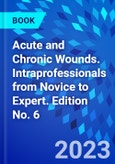Acute & Chronic Wounds, 6th Edition provides the latest diagnostic and treatment guidelines to help novice to expert clinicians provide evidence-based, high-quality care for patients with wounds. This textbook presents an interprofessional approach to maintaining skin integrity and managing the numerous types of skin damage, including topics that range from the physiology of wound healing, general principles of wound management, special patient populations, management of percutaneous tubes, and specific care instructions to program development. Written by respected wound experts Ruth Bryant and Denise Nix, this bestselling reference also provides excellent preparation for all wound certification exams.
- Comprehensive approach addresses the prevention and management of acute and chronic wounds, making it the preeminent resource for skin health and wound management across all disciplines involved in wound care, from novice to expert. - Learning Objectives at the beginning of each chapter emphasize the most important content. - Clinical Consult feature in each chapter provides a synthesis of the chapter content, illustrating how to assess, manage, and document a realistic clinical encounter using the ADPIE or SBAR framework. - Checklists provide a concise list of actions necessary to achieve the best patient care outcomes or satisfy a particular objective. - Practical tools and algorithms help in performing risk assessment, differential diagnosis, classification, treatment, and documentation. - Coverage of practice development issues addresses outcomes and productivity in agencies and institutions, home care, acute care, long-term care, and long-term acute care settings. - Self-assessment questions help you test your knowledge and prepare for certification exams. - Helpful appendices provide answers to self-assessment questions, as well as various tools, policies and procedures, competencies, patient and family education guidance, and more. - NEW! Chapters on Postacute Care Settings; Telehealth and Wound Management; Quality Tracking Across the Continuum; and Medications and Phytotherapy: Impact on Wounds provide evidence-based coverage of these important topics. - UPDATED! Consolidated pressure injuries content puts everything you need to know into one chapter. - Expanded full-color insert includes 50 new images - for a total of 95 color plates with more than 160 images - that visually reinforce key concepts. - New information presents the latest developments in biofilm assessment and management, topical oxygen therapy, skin manifestations related to COVID-19, and strategies to enhance engagement, as well as updated product photos and more authors who are clinical experts and providers.
- Comprehensive approach addresses the prevention and management of acute and chronic wounds, making it the preeminent resource for skin health and wound management across all disciplines involved in wound care, from novice to expert. - Learning Objectives at the beginning of each chapter emphasize the most important content. - Clinical Consult feature in each chapter provides a synthesis of the chapter content, illustrating how to assess, manage, and document a realistic clinical encounter using the ADPIE or SBAR framework. - Checklists provide a concise list of actions necessary to achieve the best patient care outcomes or satisfy a particular objective. - Practical tools and algorithms help in performing risk assessment, differential diagnosis, classification, treatment, and documentation. - Coverage of practice development issues addresses outcomes and productivity in agencies and institutions, home care, acute care, long-term care, and long-term acute care settings. - Self-assessment questions help you test your knowledge and prepare for certification exams. - Helpful appendices provide answers to self-assessment questions, as well as various tools, policies and procedures, competencies, patient and family education guidance, and more. - NEW! Chapters on Postacute Care Settings; Telehealth and Wound Management; Quality Tracking Across the Continuum; and Medications and Phytotherapy: Impact on Wounds provide evidence-based coverage of these important topics. - UPDATED! Consolidated pressure injuries content puts everything you need to know into one chapter. - Expanded full-color insert includes 50 new images - for a total of 95 color plates with more than 160 images - that visually reinforce key concepts. - New information presents the latest developments in biofilm assessment and management, topical oxygen therapy, skin manifestations related to COVID-19, and strategies to enhance engagement, as well as updated product photos and more authors who are clinical experts and providers.
Table of Contents
SECTION 1: Foundations1. Principles for Practice Development to Facilitate Outcomes and Productivity
2. Billing, Reimbursement, and Setting Up an Outpatient Clinic
3. Postacute Care Settings
4. Telehealth and Wound Management
5. Patient Engagement and Noncompliance
SECTION 2: Assessment
6. Quality Tracking Across the Continuum
7. Anatomy and Physiology of Skin and Soft Tissue
8. Wound-Healing Physiology and Factors that Affect the Repair Process
9. Types of Skin Damage and Differential Diagnosis
10. Skin and Wound Inspection and Assessment
SECTION 3: Pressure Injuries
11. Pressure Injuries
12. Pressure Redistribution Support Surfaces
SECTION 4: Lower Extremity Wounds
13. Lower Extremity Assessment
14. Arterial Ulcers
15. Venous Leg Ulcerations
16. Lymphedema
17. Neuropathic Wounds: The Diabetic Wound
18. Foot and Nail Care
SECTION 5: Wound Bed Preparation
19. Wound Infection and Bioburden: Detection and Management
20. Wound Debridement
21. Principles of Wound Healing and Topical Management
SECTION 6: Biophysical and Biologic Agents
22. Cellular- and/or Tissue-Based Products for Wounds
23. Molecular and Cellular Regulators
24. Negative Pressure Wound Therapy
25. Hyperbaric Oxygenation
26. Electrical Stimulation
27. Ultraviolet Light and Ultrasound
SECTION 7: Cofactors to Wound Healing
28. Wound Pain
29. Nutritional Assessment and Support
30. Medications and Phytotherapy: Impact on Wounds
31. Perfusion, Oxygenation, and Incision Care
SECTION 8: Special Populations
32. Uncommon Wounds and Manifestations of Intrinsic Disease
33. Traumatic Wounds: Bullets, Blasts, and Vehicle Crashes
34. Burns
35. Reconstructive Surgery
36. Skin Care Needs of the Patient with Obesity
37. Unique Skin Care Needs of the Neonatal and Pediatric Patient
38. Managing Wounds in Palliative Care and End of Life
39. Management of Draining Wounds and Fistulas
40. Percutaneous Tube Management
Appendix A: Examples of Tools to Support Skin and Wound Care
Appendix B: Self-Assessment Answers
Index
Authors
Ruth Bryant Partner, Bryant Rolstad Consultants, LLCProgram Director, webWOC Nursing Education Program
Minneapolis, MN. Denise Nix President, Nix Consulting Inc.; WOC Nurse Specialist, Park Nicollet Methodist Hospital, Minneapolis MN.








